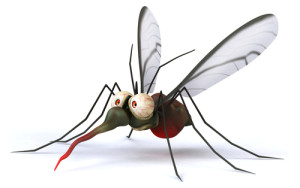Written by Renée Sharp
Being both EWG’s research director and a long-time lover of outdoor sports (perhaps ‘fanatic’ would be more accurate), I couldn’t wait for our new Guide to Bug Repellents to be released.
I’ve spent hundreds of days as a wilderness guide, hundreds more pursuing my own outdoor adventures and a good bit of time doing biological fieldwork, so I’ve encountered more than my share of mosquitos, ticks, biting flies, no see-ums and any number of other pesky bugs.
After trying everything to keep the bugs at bay—from garlic pills (no luck, but maybe I’m protected against vampires?) to citronella candles (bad idea) to bringing friends along to act as mosquito bait (mixed success) to botanical oils (high hopes, often dashed)—I broke down and bought a small bottle of 100 percent DEET to use when my stoicism about getting bitten wilted. (For the record, Alaska is quite good for testing one’s willpower about not using bug repellent.)
Listen to my Green Divas Radio Show interview for more deets on DEET…
My DEET stash always felt like a dirty little secret.
After all, my training as a biologist—and later, my work at Environmental Working Group (EWG)—taught me that chemicals can cause harm at surprisingly low levels. Plus, I will never forget the day that I decided to test whether DEET really did melt plastic. The answer was, yes, it does. (And, in case you are wondering, it will also damage the finish on your stepfather’s fake wood workbench… oops.) But were my concerns about DEET well founded? Honestly, I wasn’t totally sure.
After the child of a close friend was treated for Lyme disease, I began to consider these questions in a whole new light.
Forget about being stoic in the face of rampant mosquitos, this was a matter of getting real answers about the pros and cons of bug repellents in order to make the best possible decision for each buggy situation. I’m thrilled to finally have some good answers both for myself and to share with EWG’s fans.
So what about my stash of 100 percent DEET? I trashed it. But probably not for the reason you’d expect.
[dynamic-sidebar id=’Custom Widget 2′]
EWG’s science review concluded that although DEET certainly isn’t perfect, its safety profile is actually better than a lot of people think. Given that DEET is highly effective, reasonably safe and has been used billions of times, we concluded that it’s a reasonable choice when you need a repellent that really works.
Since there are still some reasons to have concerns about using DEET, EWG also recommends several good alternatives: Picardin, IR 3535 and Oil of Lemon Eucalyptus.
But 100 percent DEET? Bad idea.
Here’s why: The concentration of a bug repellent is related only to how long the protection will last, not how effective it is at keeping bugs off your skin. 
Since 20-30 percent DEET can provide a full day’s protection (though no repellent works for all bugs in all places), there’s no reason to expose yourself to higher concentrations. When it comes to a strong chemical such as DEET, it’s best to avoid overexposure.
So if you want to use DEET, skip the high concentrations. Opt for 7-to-10 percent if you only need a few hours of protection. If you need all-day protection, look for 20-30 percent DEET, ideally in a time-release formulation.
But, if you want to go DEET free,
GD Meg has a recipe for easy DIY bug repellant that works!
To get the full post and recipe details… click here!
Got kids? Check out our detailed recommendations here. And always follow basic precautions when using any bug repellent.
So, you might ask, what do I have in my go-to bug repellent stash now? A few weeks ago I went to REI and picked up some 30 percent DEET (which was actually the lowest concentration that they stocked), some Oil of Lemon Eucalyptus and some Picardin—so I could put EWG’s recommended DEET alternatives to the test.

I can’t say I’m hoping the bugs are bad when I head to Yosemite next weekend, but if they are, I’m ready!
Renée Sharp directs Environmental Working Group‘s toxics research program, working to educate consumers and policy makers about threats to public and environment health—and what we can do to avoid them.
Bonus!
Check out The Green Divas new podcast series, GD Spirit Pub! Listen to the pilot episode and learn more about the show … here!

Lynn Bonelli
July 16, 2014 at 11:24 am
Hello! I’m so glad to read this and share with my husband. He has insisted on using his DEET bug spray while we’ve been traveling the U.S. while I’ve protested and used homemade mixtures of “natural” bug sprays to no avail. I often end up wearing long sleeves and pants, even in 90 degree weather, while STILL getting bit dozens of times. I broken down the other day (hiking in Grand Tetons area) and used his DEET spray, feeling guilty the whole time. But it worked!
We are currently in Yellowstone and I’m sorry(?) to say, the mosquitoes are BAD. You will definitely have a good testing ground. Thanks again for sharing this information…as we head to Glacier National Park I won’t feel so bad using HIS spray. =)
Tiffany
July 25, 2014 at 4:24 pm
I LOVE the bug spray from Ava Anderson Non Toxic! It uses catnip oil (which research has found to be 10 times more effective than DEET at repelling mosquitos) and lemon eucalyptus oil (which is mentioned above). I can personally say that when I use this, I see the bugs flying all over but not a single one will land on me! 🙂